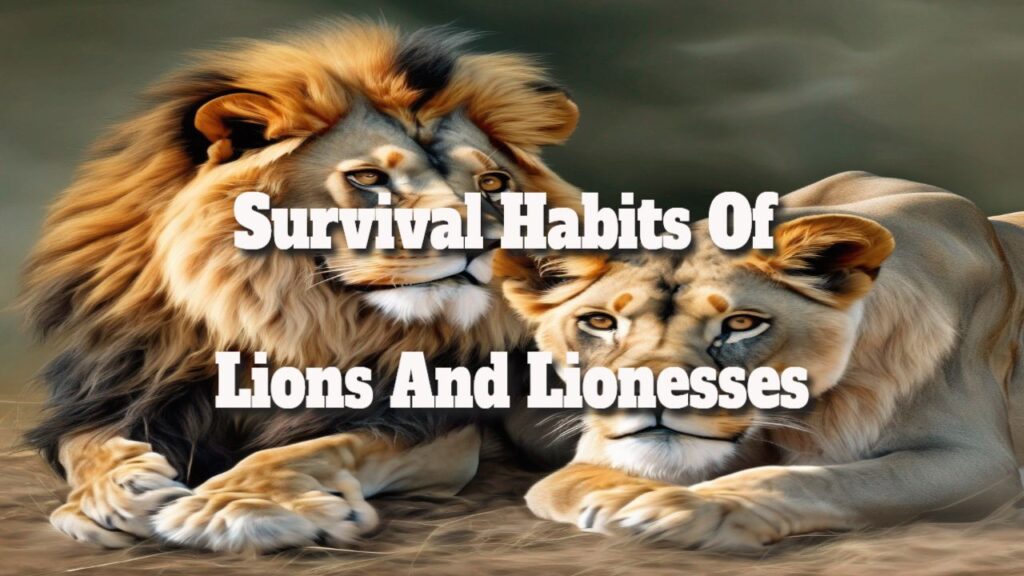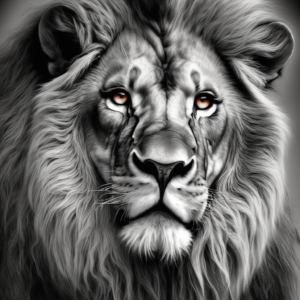Exploring the Essential Survival Skills of Lions and Lionesses
Lions and lionesses stand out as some of the most captivating animals on our planet. Renowned for their immense strength, bravery, and impressive hunting capabilities, these magnificent creatures are much more than just their physical attributes. Beyond their prowess in the wild, lions and lionesses exhibit a range of survival behaviors that are crucial for their existence in diverse ecosystems. Understanding these habits not only sheds light on their remarkable adaptability but also highlights the intricate social dynamics that govern their lives in the wilderness.
One of the most critical survival skills exhibited by lions and lionesses is their strong inclination to work collaboratively within a group. The social structure of a pride typically includes several lionesses, their young cubs, and a handful of dominant males. As inherently social creatures, each lioness adopts a specific role within the pride, contributing to communal efforts in hunting, defending their territory, and nurturing their young. This cooperative behavior is vital for their survival, enabling them to tackle larger prey and fend off potential threats from rival predators, thereby ensuring the safety of the entire pride.
Another impressive survival trait of lions and lionesses is their remarkable ability to adapt to varying environments. These powerful animals can thrive in a multitude of habitats, ranging from expansive grasslands and arid deserts to dense forests. Their adaptability extends to their hunting strategies, which they modify based on the availability of prey. For instance, if larger prey becomes scarce, they may shift their approach to target smaller animals or even resort to scavenging. This flexibility in behavior is a key factor contributing to their longevity and success as apex predators in the wild.
Understanding the Complex Social Structure of Lion Prides
Lions are inherently social animals that form tight-knit family groups known as prides. The typical composition of a pride includes several lionesses, their offspring, and typically one or two adult males. In this section, we delve into the intricate social structure of lion prides, examining the distinct roles that both lionesses and males fulfill within these groups. This social organization is critical for their survival, ensuring that every member contributes to the overall wellbeing of the pride.
Exploring the Vital Roles of Lionesses in the Pride
Within a lion pride, lionesses serve as the primary hunters, exhibiting exceptional teamwork when stalking and capturing prey. They collaborate closely to bring down larger animals, sharing the spoils with the rest of the pride to ensure all members are well-fed. In addition to their hunting responsibilities, lionesses are also dedicated caregivers, nurturing and protecting their cubs from potential dangers while teaching them essential hunting skills. The strong bonds they form through grooming and social play further enhance their unity, showcasing the importance of social interaction among lionesses in maintaining the pride's cohesion.
Examining the Hierarchical Structure Among Male Lions
Male lions assume a different, yet equally significant role within the pride. Their primary responsibility is to protect the pride from rival males and external threats, ensuring the safety of the females and their young cubs. Additionally, they play a crucial part in mating with the females to perpetuate the pride's genetic lineage. However, not all males hold the same status; a strict hierarchy exists among them, with the dominant male, often referred to as the “alpha male,” occupying the highest position. This alpha male enjoys first access to food and mating opportunities, while also leading the pride in hunts and other essential activities.
The social dynamics within lion prides are both complex and highly structured. Each member holds a specific role, contributing to the overall survival and prosperity of the group. This organized social structure not only enhances their efficiency in hunting and territory defense but also fosters strong familial bonds that are crucial for the pride's longevity.
Mastering Hunting Techniques and Identifying Prey
Collaborative Hunting Strategies of Lions
The exceptional hunting skills of lions have earned them a renowned reputation, particularly when they engage in collective hunting efforts. Prides, as cooperative hunting units, often consist of multiple lionesses, their cubs, and occasionally a few males. While the lionesses take the lead in hunting, the males typically focus on protecting the pride and asserting their dominance over the territory.
During hunts, lions employ various sophisticated strategies to capture their prey. One common approach involves encircling the target animal and launching attacks from multiple directions, utilizing their considerable strength and sharp claws to subdue it. This method proves especially effective when pursuing larger prey, such as buffalo or zebras, allowing them to leverage their teamwork for a successful kill.
Another effective hunting strategy involves the lions working in unison to exhaust their prey. By engaging the animal in a prolonged chase, the lions force it to tire out, making it easier for them to close in for the kill. This tactic not only showcases their stamina but also emphasizes their ability to work together efficiently as a unit.
Utilizing Stalking and Ambush Techniques for Effective Hunting
In addition to their team hunting strategies, lions skillfully employ stalking and ambush techniques to capture their prey. This method involves stealthily approaching the target animal while concealed by natural cover, such as tall grass or dense foliage, before launching a surprise attack. This tactic is particularly effective when hunting smaller animals like gazelles or impalas, where stealth and precision are essential for success.
Patience is a virtue for lions during hunts. They can often spend extended periods waiting for the ideal moment to strike, demonstrating remarkable stealth and self-control. Any noise or sudden movement can alert the prey, prompting it to flee, so lions must remain vigilant and composed. This calculated approach requires not only skill but also a deep understanding of their environment and the behavior of their prey.
Overall, lions showcase an impressive array of hunting techniques that highlight their prowess as predators. Their ability to coordinate as a team, coupled with their stealth and patience, solidifies their status as one of the most formidable hunters in the animal kingdom.
Examining Territorial Behavior and Habitat Preferences
Strategies for Marking and Defending Territory
Lions are well-known for their territorial behavior, often defending their designated areas against intruding prides and other predators. To assert their territory, lions utilize various methods, including scent marking through urination, rubbing their scent glands on surfaces, and vocalizing with powerful roars. These behaviors serve as a clear warning to other lions to steer clear of their established territories.
Lionesses take on the critical role of marking and defending the territory. They actively patrol the boundaries, leaving scent marks as they go, ensuring their presence is known. Furthermore, lionesses fiercely protect their territory against threats from other predators, such as hyenas and leopards, demonstrating their commitment to the safety and security of their pride.
Adapting to Various Environmental Conditions
Lions are incredibly adaptable animals capable of thriving in a wide range of habitats, from lush grasslands and savannas to dense forests. Their adaptability allows them to modify their hunting and social behaviors according to the specific environmental conditions they encounter.
In regions with thick vegetation, lions often hunt in smaller groups, utilizing the cover to ambush their prey effectively. Conversely, in open grasslands, they may opt to hunt in larger groups, harnessing their speed and endurance to chase down prey over longer distances. This versatility in hunting strategies showcases the lions' ability to adapt to their surroundings, which is crucial for their survival.
Overall, the territorial behaviors and adaptability to various environments are vital survival strategies for lions and lionesses. Their capacity to defend their territory and modify their behaviors according to changing conditions enables them to thrive in the wild.
Reproductive Strategies and Cub Rearing Practices
Understanding Mating Rituals and Reproductive Behavior
Lions and lionesses exhibit polygamous mating behaviors, involving multiple partners during the breeding season. This season typically occurs between August and November when lionesses enter estrus for a brief period lasting four to six days. During this time, lionesses mate with various males, enhancing the likelihood of successful fertilization and healthy offspring.
The competition among male lions to mate with a receptive lioness can be intense, often leading to fierce confrontations that may result in injury or even death. The victorious male will mate with the lioness multiple times over a few days, ensuring his genetic material is passed on to the next generation.
Nurturing the Next Generation: Cub Survival Skills
Once lion cubs are born, lionesses assume the primary responsibility for their care and upbringing. These tiny cubs, weighing approximately three pounds at birth, are born blind and vulnerable, relying entirely on their mother for nourishment and protection from potential threats.
Typically, lionesses give birth to litters consisting of two to four cubs, nursing them for about six months. During this critical period, lionesses impart essential survival skills to their young, teaching them how to hunt and socialize with other lions. This early education is vital for the cubs' development and future success in the wild.
As the cubs mature, they start accompanying their mothers on hunts, allowing them to learn the intricacies of stalking and capturing prey. Lionesses also educate their cubs on social interactions and essential self-defense skills, preparing them for the challenges they will face as adults.
In summary, the survival of lion cubs heavily depends on the nurturing and guidance provided by their mothers. Through attentive care and education, lionesses equip their cubs with the necessary skills to thrive independently in the wild.
Assessing the Conservation Status and Threats Facing Lions
Addressing Human-Wildlife Conflicts Impacting Lion Populations
Lions and lionesses encounter numerous threats stemming from human activities, including habitat destruction, poaching, and retaliatory killings resulting from conflicts with livestock. As human populations expand and encroach on lion habitats, the frequency of these conflicts rises. Farmers sometimes resort to killing lions to safeguard their livestock, while lions may retaliate by attacking humans in defense of their territory.
Promoting Conservation Efforts to Protect Lion Populations
In response to these pressing threats, various conservation initiatives have been launched to safeguard lion populations. One significant approach involves establishing protected areas, such as national parks and wildlife reserves, which offer safe havens for lions to flourish. Additionally, anti-poaching measures are actively enforced to deter poachers from targeting lions for their valuable body parts, thus preserving their populations.
Cooperation between conservation organizations and local communities is pivotal for mitigating human-lion conflicts. Educational programs and resources can empower farmers to protect their livestock without resorting to lethal methods against lions. Implementing effective strategies, such as physical barriers and deterrents, can further reduce these conflicts and promote coexistence.
Despite the significant threats posed by human activities, ongoing conservation efforts strive to ensure the survival of lions and lionesses for future generations, preserving these iconic creatures for all to admire.
The post Survival Habits of Lions and Lionesses appeared first on https://gqcentral.co.uk
The Article Survival Habits of Lions and Lionesses was found on https://limitsofstrategy.com





It’s fascinating how the social dynamics within a pride reflect not just survival, but also some deeper complexity in their relationships. I’ve always thought of lions as the epitome of strength and bravery, but it’s their cooperation that’s truly remarkable. The way lionesses work together for hunting and raising cubs is a perfect example of teamwork in the animal kingdom.
This post beautifully encapsulates the social intricacies of lions and lionesses and their survival skills. I’ve always found it fascinating how the dynamics within a pride mirror some aspects of human society, emphasizing collaboration and shared roles. In particular, lionesses skillfully balance the responsibilities of hunting and nurturing their young, which reminds me of communal family structures in various cultures where tasks are shared based on strengths and capacity.
You’ve touched on something really important about the connections between lion prides and human societal structures. It’s fascinating how these animal relationships can reveal aspects of our own experiences with community and collaboration. The way lionesses not only take on the vital role of hunting but also care for their young speaks volumes about the blend of responsibilities in cooperative groups.
“I’m glad you enjoyed the insights! If you’re curious to explore more about the fascinating parallels between lion behavior and human societal structures, check out this in-depth article for a deeper dive.”
https://ezinetwork.org/quillbot
It’s interesting how the dynamics within a pride can illustrate such complex social structures, much like what we see in human societies. The collaboration among lionesses is a vivid reminder of how shared responsibilities can lead to stronger communities. In many cultures, especially those that foster communal living, you often see a similar balance of roles where individuals pool their strengths for the greater good.
The parallels you draw between the dynamics within a pride of lions and human societies are truly thought-provoking. When we look at lionesses working together, it’s striking how their collaboration extends beyond mere instinct. They engage in a form of strategic teamwork that enhances their survival and enhances the overall strength of the pride. This behavior often showcases roles that are flexible, with each member contributing their unique skills to meet the collective needs.
“To explore more about the fascinating parallels between animal behavior and human societies, check out this insightful article!”
https://ezinetwork.org/ParentAler